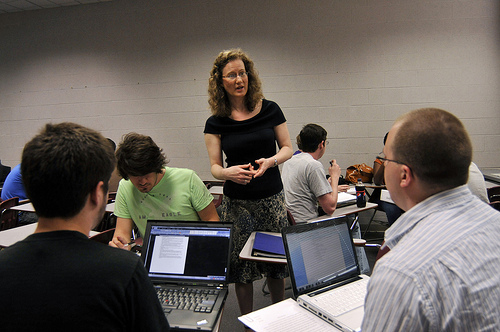Two years ago Romain Bertrand was a middle-school math teacher, finishing his fifth year teaching in North Carolina’s Charlotte-Mecklenberg district and thinking he needed a way to reach more teachers and students.
He moved to a new position mentoring and coaching teachers, but professionally, he felt stuck.
“This wasn’t going to give my career the next steps I was looking for in terms of advancement and salary,” Bertrand said. “I felt the only possibility for me was leadership roles, like principals, but I didn’t have as much passion [for that].”
This fall Bertrand is one of 26 teachers in the district to manage several classrooms at once, in a program piloting one of several models from consulting firm Public Impact to expand excellent teachers’ reach.
Paying Great Teachers More
“We were trying to achieve two goals,” said Bryan Hassel, Public Impact’s co-director. “How could you reach every child with an excellent teacher instead of just a fraction? And how could you pay teachers more, ideally a lot more, within existing budgets?”
Teachers in the Opportunity Culture pilot receive a $4,500 to $23,000 salary increase. Less active or far-reaching teachers receive less pay.
All pilot sites combine several options, which include bigger classes for excellent teachers, remote or online learning under top teachers’ instruction, subject specialization, and multi-classroom leaders who coach and support teachers.
Remote learning options include parent- and community-supervised classes.
Pilot Sites
Four low-performing Charlotte-Mecklenberg schools will pilot the program this year. Charlotte-Mecklenberg has a strong evaluation system to discover leadership capability, Hassel said, which is especially important for teachers who will lead several classrooms.
“What drew me to actual Public Impact’s work around Opportunity Culture was the question that they posed: Will we ever in our nation be able to hire, fire, and develop teachers at a fast enough rate to ensure that every student has a quality teacher?” said Denise Watts, a superintendent overseeing those schools.
Three Nashville, Tennessee schools are also piloting Opportunity Culture models this fall.
“MNPS [Metro Nashville Public Schools] embraced the Opportunity Culture framework as a reform strategy to sustainably address the persistent underperformance of participating schools,” said Derek Richey, MNPS’s director of Operational Innovation. “The three participating schools all have new leaders, so the Public Impact partnership creates a method for them to capture and implement their instructional vision.”
Other Districts Signing On
Each of the schools has created positions for multi-classroom leaders (MCLs).
“In some cases, the MCL will be responsible for one or more grade level and, in other cases, they will be responsible for a subject area,” Richey said. “In year one, there will be 11 MCLs across the three schools.”
The schools have also designed a position for 30 “aspiring teachers” from local teacher preparation programs, who tutor students, work with small groups, and so forth, like teacher’s aides.
In early May, Clark County, Nevada also signed on to pilot Opportunity Culture. It’s the fifth-largest school district in the country. Charter schools in Chicago, DC, Newark, and Minneapolis have put the models into place, too.
Teachers on Board
The declining academic achievement of those who become teachers and their declining relative wages lend urgency to efforts such as Public Impact’s to improve the teaching workforce, said John Chubb, a fellow at Stanford University’s Hoover Institution.
“So we’re not attracting [top talent] and we’re not doing a very good job of retaining—half of teachers wash out in the first five years,” Chubb said. “Wages are one issue, and the other is working conditions: A seniority system that doesn’t allow schools to reward teachers for service beyond time served.… Training and professional development systems are very weak.”
This is a huge problem, he said, because studies show teachers are the most important in-school influence on academic achievement.
The four Charlotte-Mecklenberg schools received more than 700 applications for 26 positions.
“It wasn’t expected because the only people who knew about it were the nine schools and only four were deeply immersed. We hadn’t done broad-range communication,” Watts said. “To me, it speaks to the interest. It gives people the opportunity to do something different.”
Teachers also wanted to have a say in school policies, she said.
“For the first time I have seen teachers having a voice in what reform and innovation looks like,” Watts said. “A lot of times that conversation happens at the central office, state level, federal level.”
Because many teachers love teaching, removing the less attractive elements of the job and offering them career advancement prospects and higher salaries would keep many more of the best in the profession, Bertrand said.
Measuring Success
The Public Impact team will judge how well the program has worked by measuring how much students learn academically, parent satisfaction, and how well schools implement the new ideas, Hassel said.
Key indicators of first-year success would include higher student achievement, better teacher retention, and spreading the models to other schools, Watts said.
“We won’t see the fruits of our labor until May 2014, but we’ve already hit on some of the things I would have hoped to be able to do,” Watts said. “[We’ve] created a zone that people are eager and excited to go to.”
Image by the Center for Teaching at Vanderbilt University.




